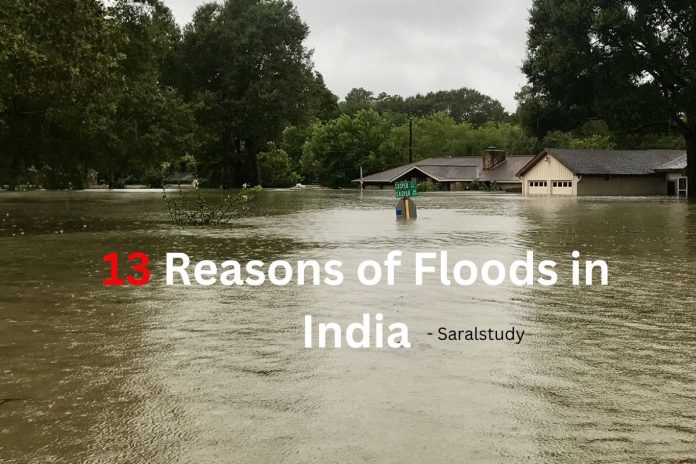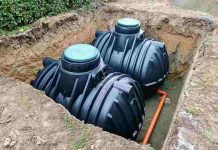More than 50% of India is flood prone. A recent survey classified more than thirty eight cities in India as being prone to floods. India has had its share of floods. Being a developing country, floods in India causes more devastation than in developed countries. The enormous and highly-concentrated population in the country compounds the problem.
13 Reason Of Floods in India
The following are the top ten reasons for floods in India.
1. Intense Monsoon Rainfall
Heavy rain floods low-lying areas. It causes flash floods. These types of floods are strong in force. The water pressure uproots trees and causes damage to property. The best way to prevent it is to have a plan that routes rainwater to an organized and controlled direction. It also helps to seal-off low lying areas with concrete structures.
2. Poor Drainage and Urbanization
New development alters the natural underground drainage system. Underground waterways lose direction. This increases the probability of a water jam below the ground. Water will slowly make its way with great force and cause floods. This problem compounds when there are storms and heavy rainfall.
- Rapid urbanization has led to encroachment on natural water bodies.
- Poorly planned cities suffer from blocked drainage systems (e.g., Mumbai & Chennai floods).
- Excessive concretization prevents rainwater absorption, causing urban floods.
3. River Overflow and Siltation
Major rivers like the Ganges, Brahmaputra, and Yamuna frequently overflow. Excessive silt deposition reduces the water-carrying capacity of rivers. Construction of dams and embankments sometimes worsens flood risks.
Encroachment of River Banks and Wetlands
- Rivers lose their natural floodplains due to illegal construction.
- Wetlands act as natural flood absorbers, but their destruction leads to higher flood risks.
4. Cyclones and Storm Surges
- Coastal states like Odisha, West Bengal, and Andhra Pradesh face flooding due to cyclones.
- Storm surges push seawater inland, submerging coastal towns.
5. Poor Infrastructure and Unplanned Development
- Encroachment on wetlands and floodplains reduces natural drainage.
- Lack of proper stormwater management leads to frequent waterlogging.
Example: Chennai floods due to construction on old lakes and canals.
6. Melting snow
By the middle of winter or early spring, many snow-stocked regions could experience snowmelt. A thaw in the mass build-up of snow occurs. The thaw releases the rigidity of snow and causes water to escape. The water spills over and cumulatively causes floods.
Spring thaw
Snow contains enormous amounts of water. During the spring season, the land is frozen. When the land is frozen, it disallows water from melting snow to seep into the ground. This water accumulates on the surface and causes floods.
7. Deforestation
Urban development causes deforestation. There are no natural barriers to hold water and thus floods happen.
- Cutting down forests reduces the ability of soil to absorb rainwater.
- This leads to rapid runoff into rivers, causing flash floods.
- Himalayan states suffer from landslides due to deforestation.
8. Dam Failures and Sudden Water Release
Old dams pose an environmental hazard. If there is a failure in the dam, water contained can come out and flood the entire region in a matter of minutes. Dams can fail without anyone knowing about it. Heavy rainfall could cause a dam-break. Sudden release of water from dams during monsoons worsens flooding.
Example: 2018 Kerala floods worsened due to the release of water from multiple dams.
9. Wildfires
Flood after fire Flood can happen after wildfires. The wildfire chars the ground. The ground loses the ability to absorb water. Over a period of time, rainwater accumulates on the ground surface. It slowly starts gaining momentum and induces a flood.
10. Ice jams
Prolonged cold weather freezes the surface of water bodies. It is common to see frozen rivers during the cold season. Extreme cold weather can freeze an entire river. After some time, thaws appear on the ice surface. The ice starts to chunk. The ice chunks cause obstruction to the natural flow of the river water. This causes flooding. Water flows in uncontrolled directions.
11. Mudflows
Heavy rains and brush loss cause mudflow. Mudflows are characterized by fast moving mass of liquid and mud on dry land. Mudflow happens due to water saturation. When there is a snowmelt, a mudflow can happen. This causes a thick mass of moving liquid and mud that comes downhill at great velocity. Mudflows are a type of landslide.
12. Flash Floods Due to Cloudbursts
Cloudbursts occur when sudden intense rainfall dumps huge amounts of water in a short time.
Example: The 2013 Uttarakhand floods were triggered by a cloudburst and was one of the worst case of floods in India.
13. Earthquakes
An Earthquake can cause tsunamis which cause a rapid excursion of water from the middle of the sea and flooding into land.
Also Read: Top 10 Reasons of Earthquake in India





